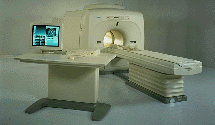 | Info
Sheets |
| | | | | | | | | | | | | | | | | | | | | | | | |
 | Out-
side |
| | | | |
|
| | | | | |  | Searchterm 'Sequences' was also found in the following services: | | | | |
|  |  |
| |
|
From Toshiba America Medical Systems Inc.;

FLEXART™ series is a 0.5 T superconducting MRI system that has been designed to meet the expanding role of MRI in today's clinical environment. The system utilizes innovative technologies such as digital RF, high speed actively shielded gradients and optimized RF coils which support a wide range of MRI developments.
Device Information and Specification
CLINICAL APPLICATION
Whole body
Quadrature, solenoid and multi-channel configurations
SE, FE, IR, FastSE, FastIR, FastFLAIR, Fast STIR, FastFE, FASE, Hybrid EPI, Multi Shot EPI; Angiography: 2D(gate/non-gate)/3D TOF, SORS-STC
IMAGING MODES
Single, multislice, volume study
POWER REQUIREMENTS
380/400/415/440/480 V
COOLING SYSTEM TYPE
Closed-loop water-cooled
| |  | | | |
|  |  | Searchterm 'Sequences' was also found in the following services: | | | | |
|  | |  | |  |  |  |
| |
|
( FISP) A fast imaging sequence, which attempts to combine the signals observed separately in the FADE sequence, generally sensitive about magnetic susceptibility artifacts and imperfections in the gradient waveforms. Confusingly now often used to refer to a refocused FLASH type sequence. This sequence is very similar to FLASH, except that the spoiler pulse is eliminated. As a result, any transverse magnetization still present at the time of the next RF pulse is incorporated into the steady state.
FISP uses a RF pulse that alternates in sign.
Because there is still some remaining transverse magnetization at the time of the RF pulse, a RF pulse of a degree flips the spins less than a degree from the longitudinal axis.
With small flip angles, very little longitudinal magnetization is lost and the image contrast becomes almost independent of T1. Using a very short TE (with TR 20-50 ms, flip angle 30-45°) eliminates T2* effects, so that the images become proton density weighted. As the flip angle is increased, the contrast becomes increasingly dependent on T1 and T2*. It is in the domain of large flip angles and short TR that FISP exhibits vastly different contrast to FLASH type sequences.
Used for T1 orthopedic imaging, 3D MPR, cardiography and angiography. | |  | |
• View the DATABASE results for 'Fast Imaging with Steady State Precession' (5).
| | | | |  Further Reading: Further Reading: | Basics:
|
|
| |
|  |  | Searchterm 'Sequences' was also found in the following services: | | | | |
|  |  |
| |
|
(FLASH) A fast sequence producing signals called gradient echo with low flip angles. FLASH sequences are modifications, which incorporate or remove the effects of transverse coherence respectively.
FLASH uses a semi-random spoiler gradient after each echo to spoil the steady state (to destroy any remaining transverse magnetization) by causing a spatially dependent phase shift. The transverse steady state is spoiled but the longitudinal steady state depends on the T1 values and the flip angle. Extremely short TR times are possible, as a result the sequence provides a mechanism for gaining extremely high T1 contrast by imaging with TR times as brief as 20 to 30 msec while retaining reasonable signal levels. It is important to keep the TE as short as possible to suppress susceptibility artifacts.
The T1 contrast depends on the TR as well as on flip angle, with short TE.
Small flip angles and short TR results in proton density, and long TR in T2* weighting.
With large flip angles and short TR result T1 weighted images.
TR and flip angle adjustment:
TR 3000 ms, Flip Angle 90°
TR 1500 ms, Flip Angle 45°
TR 700 ms, Flip Angle 25°
TR 125 ms, Flip Angle 10°
The apparent ability to trade TR against flip angle for purposes of contrast and the variation in SNR as the scan time (TR) is reduced.
See also Gradient Echo Sequence. | | | |  | |
• View the DATABASE results for 'Fast Low Angle Shot' (5).
| | | | |  Further Reading: Further Reading: | News & More:
|
|
| |
|  |  | Searchterm 'Sequences' was also found in the following services: | | | | |
|  |  |
| |
|
(FAT SAT) A specialized technique that selectively saturates fat protons prior to acquiring data as in standard sequences, so that they produce a negligible signal. The presaturation pulse is applied prior to each slice selection. This technique requires a very homogeneous magnetic field and very precise frequency calibration.
Fat saturation does not work well on inhomogeneous volumes of tissue due to a change in the precessional frequencies as the difference in volume affects the magnetic field homogeneity. The addition of a water bag simulates a more homogeneous volume of tissue, thus improving the fat saturation. Since the protons in the water bag are in motion due to recent motion of the bag, phase ghosts can be visualized.
Fat saturation can also be difficult in a region of metallic prosthesis. This is caused by an alteration in the local magnetic field resulting in a change to the precessional frequencies, rendering the chemical saturation pulses ineffective.
See also Fat Suppression, and Dixon. | | | |  | |
• View the DATABASE results for 'Fat Saturation' (9).
| | | | |  Further Reading: Further Reading: | | Basics:
|
|
News & More:
| |
| |
|  | |  |  |
|  | |
|  | | |
|
| |
 | Look
Ups |
| |